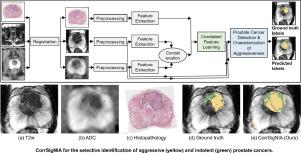Medical Image Analysis ( IF 10.7 ) Pub Date : 2021-11-06 , DOI: 10.1016/j.media.2021.102288 Indrani Bhattacharya 1 , Arun Seetharaman 2 , Christian Kunder 3 , Wei Shao 4 , Leo C Chen 5 , Simon J C Soerensen 6 , Jeffrey B Wang 4 , Nikola C Teslovich 5 , Richard E Fan 5 , Pejman Ghanouni 1 , James D Brooks 5 , Geoffrey A Sonn 7 , Mirabela Rusu 4

|
Automated methods for detecting prostate cancer and distinguishing indolent from aggressive disease on Magnetic Resonance Imaging (MRI) could assist in early diagnosis and treatment planning. Existing automated methods of prostate cancer detection mostly rely on ground truth labels with limited accuracy, ignore disease pathology characteristics observed on resected tissue, and cannot selectively identify aggressive (Gleason Pattern4) and indolent (Gleason Pattern=3) cancers when they co-exist in mixed lesions. In this paper, we present a radiology-pathology fusion approach, CorrSigNIA, for the selective identification and localization of indolent and aggressive prostate cancer on MRI. CorrSigNIA uses registered MRI and whole-mount histopathology images from radical prostatectomy patients to derive accurate ground truth labels and learn correlated features between radiology and pathology images. These correlated features are then used in a convolutional neural network architecture to detect and localize normal tissue, indolent cancer, and aggressive cancer on prostate MRI. CorrSigNIA was trained and validated on a dataset of 98 men, including 74 men that underwent radical prostatectomy and 24 men with normal prostate MRI. CorrSigNIA was tested on three independent test sets including 55 men that underwent radical prostatectomy, 275 men that underwent targeted biopsies, and 15 men with normal prostate MRI. CorrSigNIA achieved an accuracy of 80% in distinguishing between men with and without cancer, a lesion-level ROC-AUC of 0.810.31 in detecting cancers in both radical prostatectomy and biopsy cohort patients, and lesion-levels ROC-AUCs of 0.820.31 and 0.860.26 in detecting clinically significant cancers in radical prostatectomy and biopsy cohort patients respectively. CorrSigNIA consistently outperformed other methods across different evaluation metrics and cohorts. In clinical settings, CorrSigNIA may be used in prostate cancer detection as well as in selective identification of indolent and aggressive components of prostate cancer, thereby improving prostate cancer care by helping guide targeted biopsies, reducing unnecessary biopsies, and selecting and planning treatment.
中文翻译:

通过 CorrSigNIA 选择性识别和定位惰性和侵袭性前列腺癌:MRI-病理学相关性和深度学习框架
用于检测前列腺癌并在磁共振成像 (MRI) 上区分惰性和侵袭性疾病的自动化方法可以帮助早期诊断和治疗计划。现有的前列腺癌检测自动化方法大多依赖于真实标签,准确性有限,忽略了在切除组织上观察到的疾病病理特征,无法选择性地识别侵袭性(格里森模式)4) 和惰性 (Gleason Pattern=3) 癌症共存于混合病变中。在本文中,我们提出了一种放射学-病理学融合方法 CorrSigNIA,用于在 MRI 上选择性识别和定位惰性和侵袭性前列腺癌。CorrSigNIA 使用来自根治性前列腺切除术患者的注册 MRI 和整体组织病理学图像来推导准确的基本事实标签并学习放射学和病理学图像之间的相关特征。然后将这些相关特征用于卷积神经网络架构,以在前列腺 MRI 上检测和定位正常组织、惰性癌症和侵袭性癌症。CorrSigNIA 在 98 名男性的数据集上进行了训练和验证,其中包括 74 名接受根治性前列腺切除术的男性和 24 名前列腺 MRI 正常的男性。CorrSigNIA 在三个独立的测试集上进行了测试,包括 55 名接受根治性前列腺切除术的男性、275 名接受靶向活检的男性和 15 名前列腺 MRI 正常的男性。CorrSigNIA 在区分患有和未患有癌症的男性方面达到了 80% 的准确度,病变水平 ROC-AUC 为 0.810.31 在根治性前列腺切除术和活检队列患者中检测癌症,病变水平 ROC-AUC 为 0.820.31 和 0.860.26 在根治性前列腺切除术和活检队列患者中分别检测具有临床意义的癌症。CorrSigNIA 在不同的评估指标和队列中始终优于其他方法。在临床环境中,CorrSigNIA 可用于前列腺癌检测以及选择性识别前列腺癌的惰性和侵袭性成分,从而通过帮助指导靶向活检、减少不必要的活检以及选择和规划治疗来改善前列腺癌护理。











































 京公网安备 11010802027423号
京公网安备 11010802027423号